Tags
All Saints church, Brindley's Mill, James Brindley, Leek Staffordshire, murals, Richard Norman Shaw, stained glass
During our day in Leek (mentioned in a former post), we also re-visited two favourite places.
This post is written with some help from the information booklets I obtained from All Saint’s Church, Leek and Brindley’s Mill, Leek.
ALL SAINTS CHURCH
This church was designed by Richard Norman Shaw (1831-1912) and is considered the finest of all the sixteen he worked on. He mainly designed great houses and public buildings – 200 are attributed to him – including ‘Cragside’ in Northumberland and New Scotland Yard in London, the former headquarters of the Metropolitan Police. He followed A W N Pugin’s methods and principles which included honesty in the use of materials and the use of local building stone wherever possible. He also worked for some years as assistant to George Edmund Street and many of Street’s principles can be seen in Shaw’s churches – very low chancel screens without superstructure and the altar visible from all parts of the building.

The High Altar. The beautiful painted Reredos shows Christ’s Crucifixion and the Great East Window behind, designed by the artist Edward Burne-Jones, is a ‘Jesse’ window and shows the ancestry of Christ.
This was the third time we had visited this church and each time we have been there we have been welcomed and shown wonderful hospitality by the parishioners who open their church to visitors twice a week, provide coffee, tea and biscuits and lots of information and chat.
The stained glass windows are sumptuously coloured.
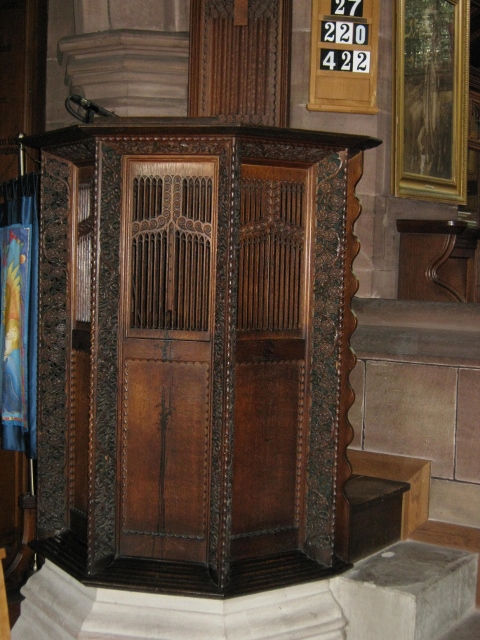
The pulpit is decorated beautifully with carving and pierced woodwork. It also has a tester or sounding board above it which helped with acoustics before the use of microphones.
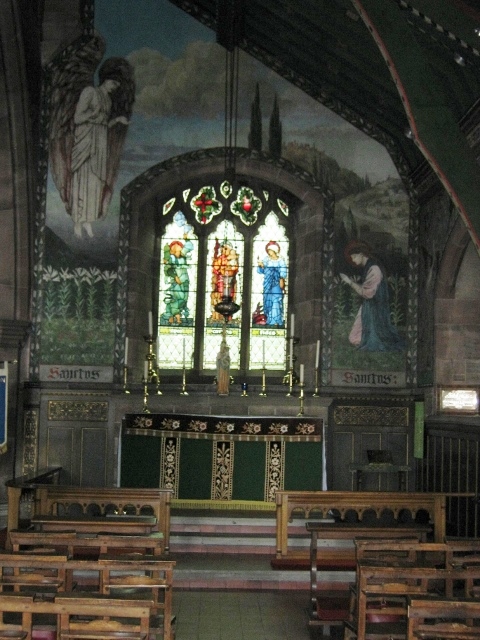
The highly decorated Lady Chapel. The wall painting shows the Annunciation, the visit of the Angel Gabriel to Mary when she is told she has been chosen to be the Mother of Christ.
Another painting in the Lady Chapel and on the south wall is of St Francis of Assisi preaching to the birds. Unfortunately the photographs I took were not good enough as the light levels were poor.
- Wall painting
- Wall painting
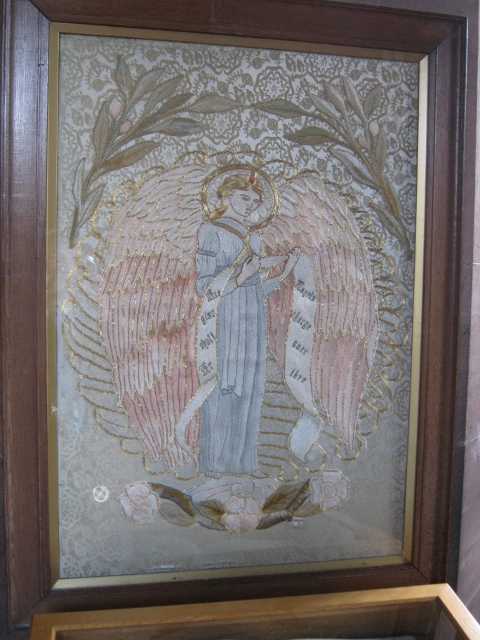
A framed embroidery of an angel – a late example of the work of a member of the Leek School of Embroidery.

The font is made from green marble and the floral design on the west wall behind it is believed to be by William Morris.
BRINDLEY’S MILL
Our next port of call was to Brindley’s Mill. As it is on a busy road I was unable to take a photograph of the outside of the mill so I have found a picture of it on-line – thanks to the Peak District On-line site.
I also found a photograph of what it looked like before successive roadworks raised the road level and caused the demolition of part of the building in 1948. This photograph comes from the Staffordshire Past Track site.
James Brindley was born in 1716, the eldest of the seven children of a Derbyshire small farmer. Brindley had very little schooling as he was kept very busy on the farm. The family moved to Leek when he was ten and at the age of seventeen he was apprenticed to a millwright near Macclesfield in Cheshire. He had a wonderful memory and stored up all sorts of useful information that he gleaned on his trips with journeymen to a variety of mills in the area. After two years his grasp of mechanical detail was remarked on by a mill manager and when the millwright to whom he was apprenticed failed to produce machinery for a new paper mill, Brindley, on his own initiative, visited the mill fifty miles away to see what was required. He was subsequently put in charge of the work which was completed satisfactorily. He thereafter looked after the business until the millwright’s death. Brindley set up his own millwright’s business in 1742 at the age of 26. He opened up another workshop in the Potteries where, after working with master potters and colliery owners he became known as ‘The Schemer’. His mill work continued including water mills for corn, flint and textiles, all requiring different internal machinery. Where no water was available he used ‘fire engines’ as early steam pumps were known. He patented improvements to existing machines. He replaced water by wind in Burslem for grinding flint for the Wedgewoods.
Brindley built the cornmill in Leek in 1752 on a site where a mill had stood since Domesday, on the River Churnet.
In constructing this mill he showed a variety of skills – a millwright’s knowledge of mechanics and hydraulics was accompanied by the ability to create a stylish building using new weight-bearing techniques. He also exhibited civil engineering skills when constructing the weir by compacting clay, as he did later when forming the beds of the canals he made. His canals transformed the way goods were transported across England and he became very famous. Because of his lifestyle – constant travelling, overwork and also the onset of diabetes – he died at the early age of 56.
Four photos of the tentering gear (three sets of different vintages are bolted to the ceiling). They adjust the gaps between the millstones on the floor above to control the fineness of the flour.

At the rear of the photo is the pit wheel which is connected to the waterwheel outside by the axle-tree. The main shaft is made of oak and is 18″ in diameter. It is supported by a brass footstep bearing which is bolted to the floor. Around the base of the main shaft is the wallower – a gear which is driven by the pit wheel. At the front of the photo is the wooden pipe which conveys the meal from the millstones above. The meal is then sieved.

This is a photo of the next floor. Grain is poured into the wooden hopper from the floor above. The new hopper here is a quarter scale replacement to make demonstrations easier. Below the hopper is a tray (the shoe). One of the arms attached to the shoe is held against the rotating four-sided shaft by a rope attached by a springy bar of willow. As the shaft turns its four edges create a shuddering movement in the shoe which allows the grain to be jerked out at a regular pace into the eye of the top stone.
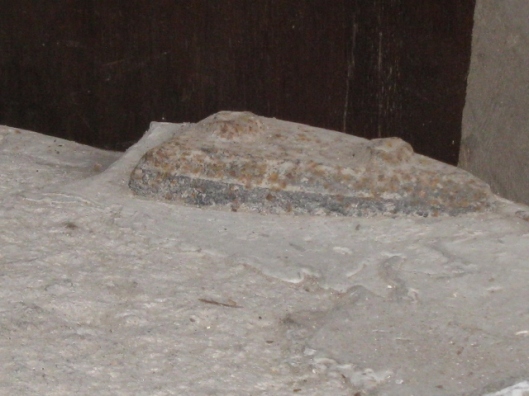
If the stone became worn or it ground unevenly it could be repaired by being weighted on one side. This one has been weighted by an old flat iron.

The Garner floor or top floor where the grain is stored prior to milling. The sacks are conveyed up to this floor with a sack hoist
This is a theodolite level – a spirit level above a telescope above a compass – and was the most advanced piece of technology which he used in planning his canals.

This is one of four of Brindley’s notebooks in existence and are mainly aids to his memory – time taken to ride to distant places, where he found suitable timber, clothes he bought, how much he was owed etc.
The following day, which was Sunday, we attended church at All Saints and had coffee afterwards in their large church room in the undercroft. Such friendly people!
We then travelled to Manchester and spent some time visiting my mother-in-law in her house. Probably the last time I will see the house, though I didn’t realise it then.










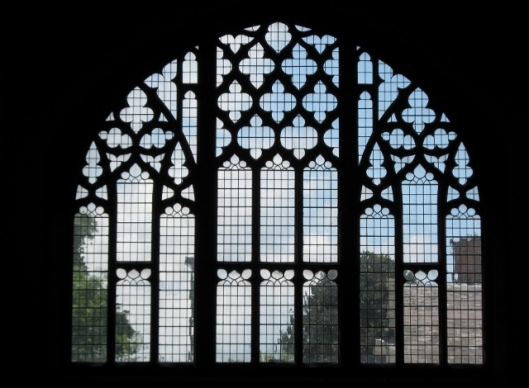
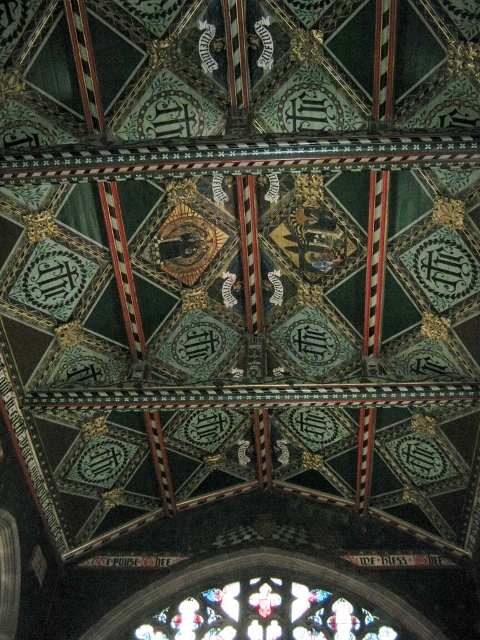


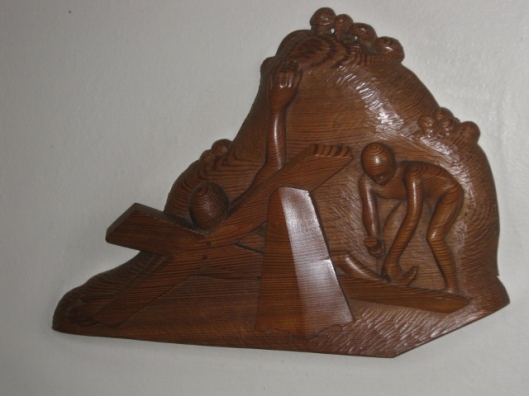
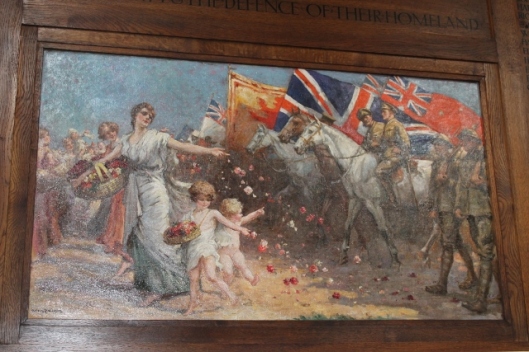
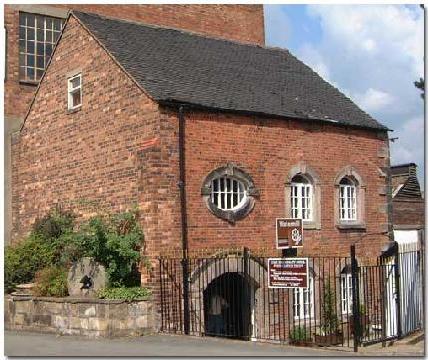
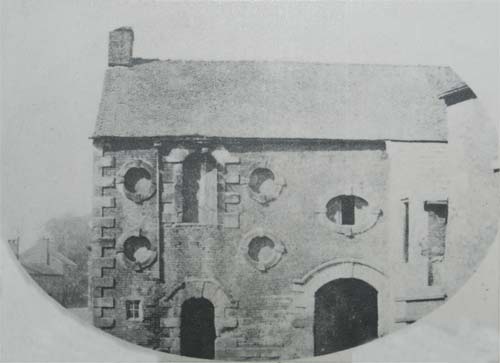






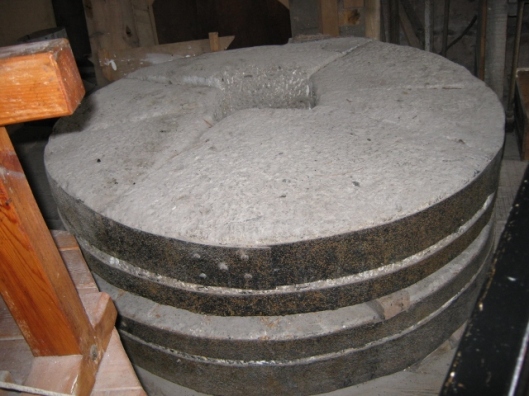
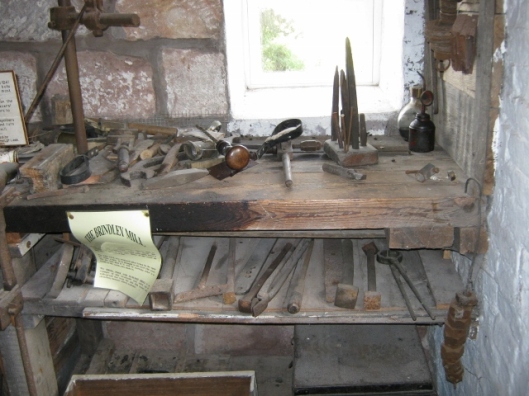
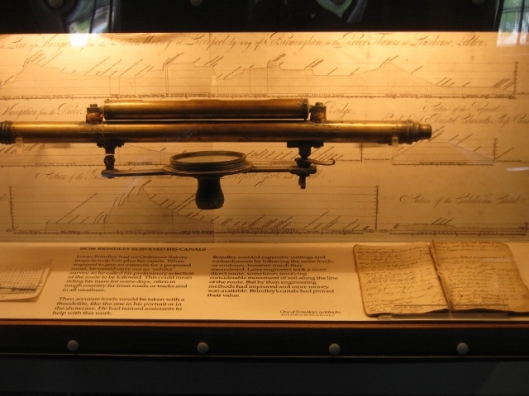
Wow! I thought that the All Saint’s Church with all of the ornate carvings and stained glass windows were a treat, but I really got a kick out of reading about James Brindley and seeing what he was able to accomplish with what he had to work with back in those days. Being mechanically inclined, of course I would gravitate in that direction. 😉
LikeLiked by 1 person
Thank-you very much Jerry. James Brindley was an amazing man who seemed to be able to turn his hand to anything. A real hero as a man and an engineer he was responsible for about 360 miles of canals in England speeding up transportation of goods. This hastened the Industrial Revolution. He did all this without making any drawings or written calculations!
LikeLike
That’s a beautiful church and so massive it looks like it could be part of a castle. The windows are amazing and so is the artwork.
You’d probably find that I had snuck away from the church and was hanging out in the mill though. I love places like that and could spend days there. Mr. Brindley was quite a man. I worked in a machine shop once run by a man who reminds me of him. The things he could build with just his thoughts as a guide were astounding. I never even saw him do a sketch of any machine he ever built.
Thank you for another great tour!
LikeLiked by 1 person
Thank-you Allen! Brindley was a genius I think. With very little education he managed to achieve so much. He had innate engineering skill and knew instinctively what needed doing and how to do it. Really amazing!
LikeLike
You would more likely find me in the mill too as I dearly love a working mill.
LikeLiked by 1 person
They are fascinating places.
LikeLike
Reblogged this on A Suffolk Lane and commented:
Apologies to all of you who have already received this post. A number of you didn’t including my Facebook friends so I am reblogging it
LikeLike
Beautiful details in the church, as well as beautiful parishioners it seems. 🙂
LikeLiked by 1 person
Thank-you, Gallivanta, it was an entirely pleasurable visit.
LikeLiked by 1 person
Life and culture well captured, that waterwheel rolled towards me as I scrolled down
LikeLike
Thank-you!
LikeLike